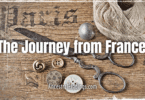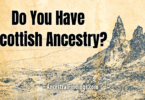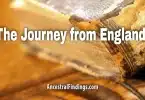If your family has lived in North America for more than a few generations, chances are that part of your story began in England. For centuries, English men and women boarded ships that sailed toward an uncertain horizon, leaving behind familiar fields and cathedrals for a world they knew only through rumor and prayer.
To trace English ancestry is to follow the roots of early America itself. The language we speak, the laws we live under, and even the shape of our small towns carry the fingerprints of those who crossed the Atlantic centuries ago. But their story is not abstract history—it’s the story of people like us, who dreamed of something better and faced the fear of never going home.
Leaving England
The first great wave of English migration began in the early 1600s. The world was changing fast. The population was growing, cities were crowded, and the Reformation had torn old certainties apart. For some, religion offered comfort. For others, it was the reason to flee.
Puritans, who wanted to purify the Church of England, faced punishment at home. Quakers, who refused to swear oaths or serve in the military, were fined and jailed. Even loyal Anglicans saw opportunity across the sea as England’s economy tightened.
In 1607, a small group of Englishmen founded Jamestown, the first permanent settlement in Virginia. Thirteen years later, the Mayflower carried another group to the shores of Massachusetts. Between them, these communities formed the seed of English-speaking America.
The people who followed were not all saints or adventurers. Many were tradesmen, farmers, or servants. Some were orphans sent to labor in the colonies. Others were prisoners of war or debtors. The colonies needed workers, and England had plenty of people with no land, no prospects, and nothing left to lose.
The Voyage
Crossing the Atlantic was not a simple journey. It could take six to ten weeks, depending on winds and storms. The ships were small, dark, and crowded. Food spoiled, water went foul, and disease spread quickly.
Passengers slept in tight quarters below deck. Rats and lice were constant companions. The sound of the sea was always there—sometimes a whisper, sometimes a roar that made the whole ship tremble.
And yet, they came. Every voyage carried the same mixture of fear and hope. A new life waited on the other side, though no one could say what kind of life it would be.
When the ships finally reached the American coast, the sight of trees, rivers, and sunlight was often overwhelming. Letters home describe settlers falling to their knees and weeping at the sight of land.
Building a New Life
English settlers brought their customs with them. They built towns centered around churches and greens. They established county governments modeled after those in England. They formed militias, elected local councils, and built schools for their children.
These settlers weren’t just surviving—they were rebuilding the world they had left behind. Town names like Plymouth, Bristol, York, and Cambridge appeared on maps, quiet echoes of their origins. Even their houses—timber frames, thatched or shingled roofs, small-paned windows—mirrored the homes of southern England and East Anglia.
In New England, Puritans worked together as communities, sharing labor and responsibility. In Virginia and Maryland, settlers from the south of England created plantations and relied on indentured servants to tend the tobacco fields. In the Carolinas and Georgia, English settlers mingled with Scots, Irish, and Africans, forming the foundation of Southern culture.
The English presence in North America was not uniform, but it was everywhere—woven into every colony and every social class.
The Records They Left Behind
One of the advantages of tracing English ancestry is the wealth of documentation they left on both sides of the ocean. The English were record keepers.
Parish registers—records of baptisms, marriages, and burials—began in 1538, under the order of King Henry VIII. These are among the oldest continuous genealogical sources in the world. Many are still kept in parish churches or local archives, and millions have been digitized.
Wills and probate records are another valuable source. English law required the settlement of estates through the courts, which produced detailed records listing heirs, property, and even the contents of houses.
Apprenticeship records, manorial rolls, and tax lists add more detail about where and how people lived. For those who emigrated, passenger lists and letters of indenture sometimes record their names, occupations, and destinations.
In America, those same English settlers continued their habit of record keeping. Early church books, land deeds, and probate files are filled with familiar names and handwriting styles—sometimes the very same family lines that appear in the old parish registers of Devon, Kent, or Yorkshire.
Clues in Names and Language
Some English surnames are so widespread that they became part of the fabric of America itself. Names like Smith, Taylor, Clark, Wright, Baker, Cook, Hill, Allen, and Green appear in records from the 1600s onward. These names reflected trades, features of the land, or personal traits.
Regional surnames can sometimes reveal origins. The name Devonshire likely points to southwestern England, while Kent, Cornwall, or Salisbury suggest particular counties or towns. Names ending in “-ton” or “-ham” (like Hampton or Worthingham) often trace back to English place names.
Given names tell their own story. In English families, it was common for sons to be named after fathers or grandfathers and daughters after mothers or grandmothers. This pattern can help identify relationships when multiple generations used the same small set of names.
Why the Story Still Matters
By the time of the American Revolution, people of English descent formed the largest portion of the colonial population. Yet few still thought of themselves as English. They had become something new—colonials, and soon, Americans.
Even so, English culture left a deep mark. The structure of government, trial by jury, public schools, and common law all came from English roots. The traditions of town meetings in New England and county courts in Virginia both reflect England’s long history of local self-rule.
Understanding English ancestry helps explain more than family lines; it helps explain why our societies function the way they do.
Even if your DNA test shows no direct English blood, much of modern life in North America rests on English foundations. Every time you hear a town name like Lancaster or Portsmouth, or see a courthouse with Georgian columns, you’re seeing echoes of those who made that crossing centuries ago.
Tracing Them Today
Modern research tools have made tracing English ancestry easier than ever. DNA testing can connect you to distant cousins in England who still live near your ancestral villages. Online databases such as FindMyPast, FamilySearch, and The National Archives provide access to centuries of English records.
If you find a specific place name in your family history, explore its local archives or church registries. Many county archives in England have volunteers who assist with genealogy inquiries. Towns like Norfolk, Essex, and Somerset maintain record offices with parish books that go back nearly 500 years.
When working with English records, remember that spelling was inconsistent. A name might appear differently in each generation. Dates may also vary slightly depending on old calendar systems. These inconsistencies are part of the charm of old research—they remind you that every name belonged to a living person.
A Heritage Shared by Many
Today, tens of millions of people in the United States and Canada have English ancestry, even if they don’t know it. Many families with long North American roots descend from early English settlers who arrived centuries before Ellis Island existed.
Some rediscover their connection through DNA results. Others find it while walking through a New England cemetery or exploring a family Bible that mentions a distant “John from Kent” or “Mary from Devon.”
The truth is that English heritage belongs to everyone touched by that early migration. Whether your family came in 1620 or 1920, the cultural thread remains the same—a search for a better life, carried across the sea.
The Meaning of the Search
To study English ancestry is to trace the path of ordinary people who built extraordinary things. They were not kings or generals, but they left behind something lasting: a world that balanced memory and change.
Each name found in a parish book or ship register is a voice from the past, speaking across centuries. Together, they form the story of how one island’s people helped shape the identity of a continent.
And as you uncover your own family’s story, you join a long tradition of curiosity—a connection between generations who all, in some way, crossed their own oceans of time.
Share Your Story
Do you have English ancestry? Perhaps your ancestors left from the ports of Bristol or Plymouth, or maybe you have a family letter mentioning an English village.
Share your discoveries and stories on YouTube or Facebook. Your story might inspire others to uncover their own connection to England—a connection that began with courage, endurance, and hope, carried across the Atlantic by those who built a new life from the old world.






